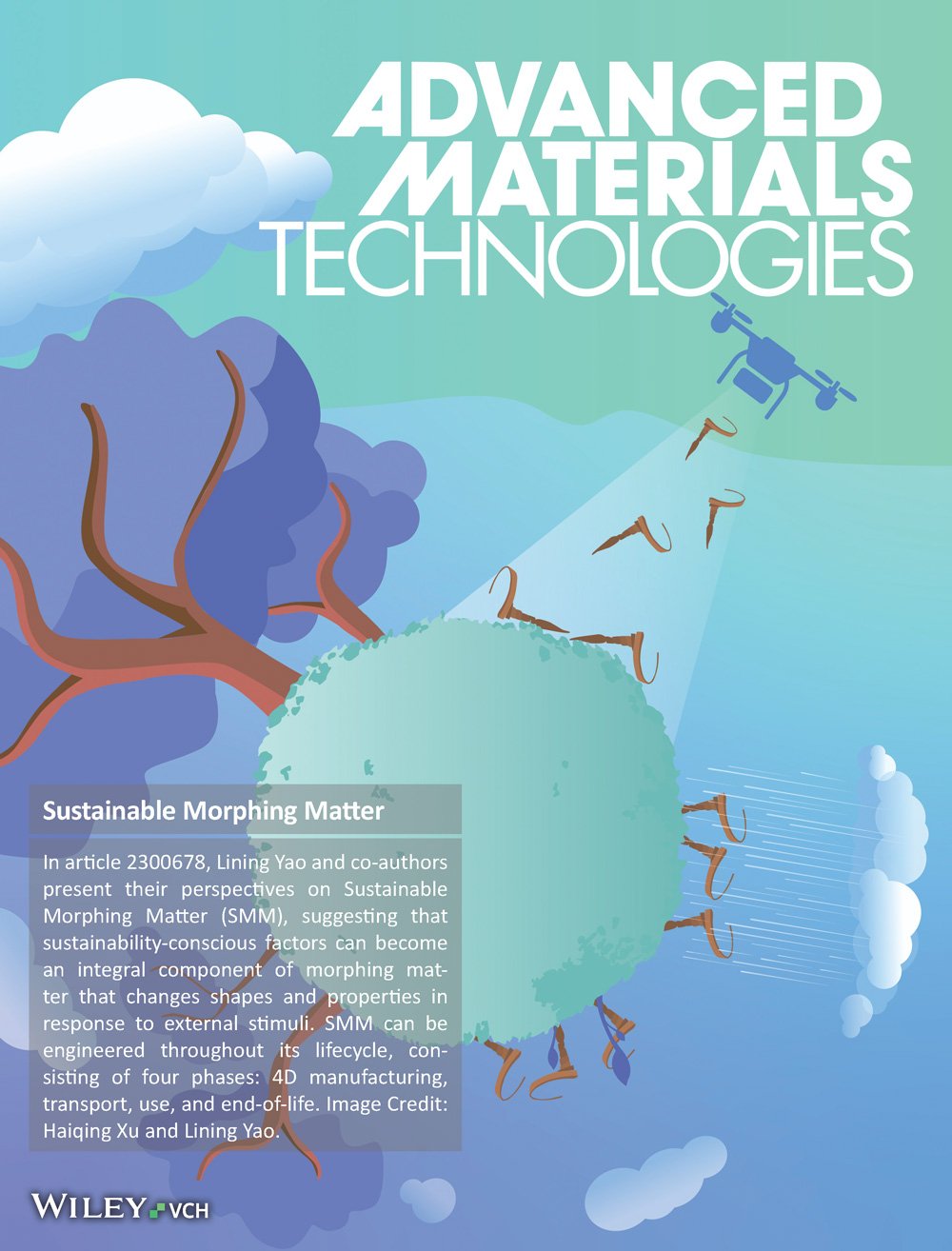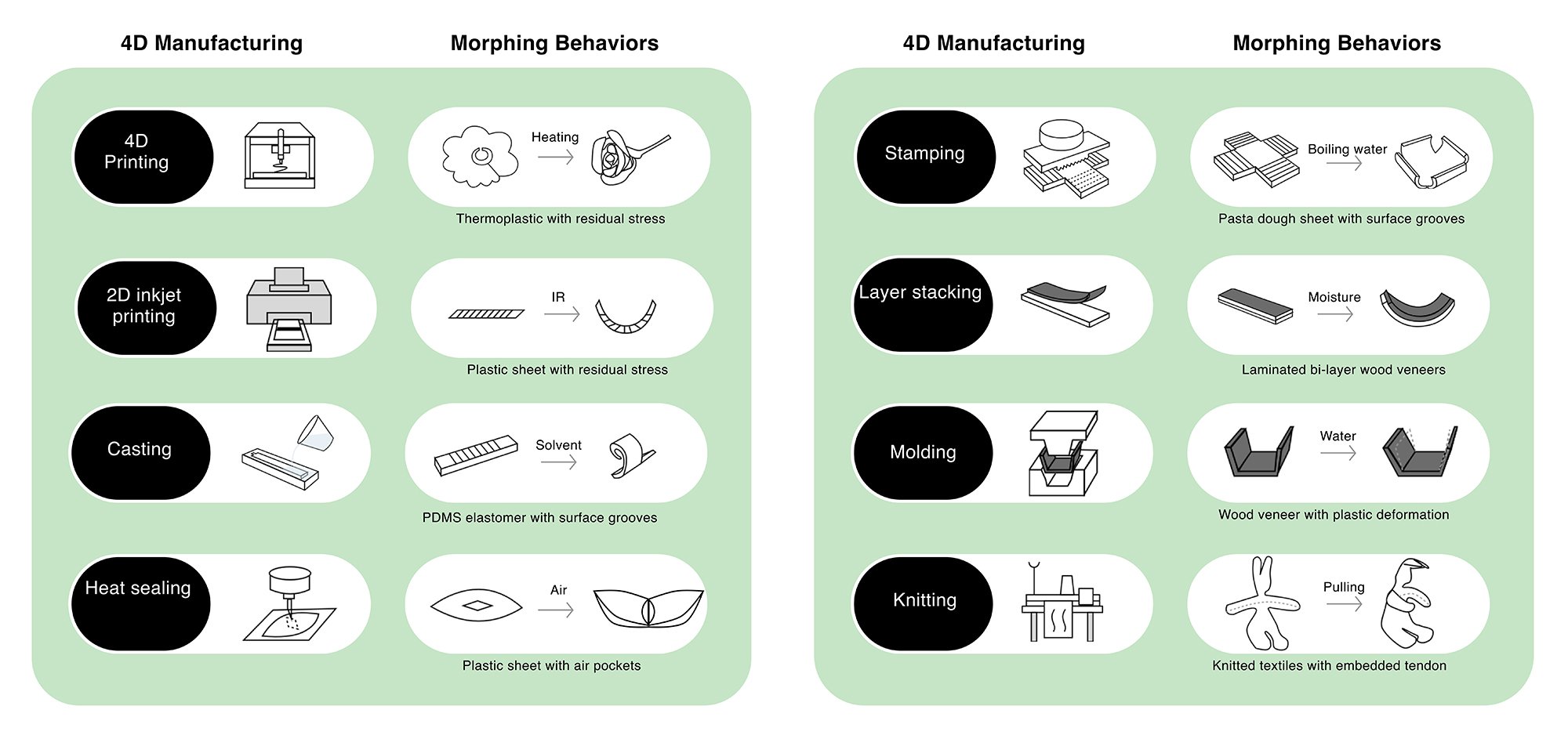Sustainable Morphing Matter: Design and Engineering Practices
Dinesh K. Patel*, Ke Zhong*, Haiqing Xu, Mohammad Islam and Lining Yao✉. Advanced Materials Technologies. 2023. PDF | DOI
A Perspective Vision Paper | *Equally Contribute
🏅 Frontispiece Feature
In this perspective paper, the term “sustainable morphing matter” (SMM) is coined, suggesting that sustainability-conscious factors can become an integral component of morphing matter. In addition, ways to apply sustainability-conscious factors to augment the existing design pipeline of morphing matter are presented, and more quantitative and algorithmic-level developments are needed to apply these factors rigorously to the design process.
<—Figure 1. Representative examples of sustainable morphing matter (SMM), whether used in its natural form or incorporated into devices, actuators, and robots, demonstrating different approaches to integrate sustainable design considerations into the engineering and use of morphing matter. The examples include self-burying seed carrier. Reproduced with permission.[16] Copyright 2023, Springer Nature. Morphing pasta. Reproduced under the term of CC-BY license.[17] Copyright 2021, The Authors, published by American Association for the Advancement of Science. HASEL cardboard gripper. Reproduced under the term of CC-BY license.[18] Copyright 2023, The Authors, published by American Association for the Advancement of Science. Self healing robot.[19,31] Reproduced under the term of CC-BY licence.[19] Copyright 2017, The Authors, published by American Association for the Advance- ment of Science. Reproduced under the term of CC-BY license.[31] Copyright 2019, The Authors, University of Cambridge. Logic-enabled textile.[22,32] Reproduced under the term of CC-BY license.[22] Copyright 2022, National Academy of Sciences. Reproduced with permission.[32] Copyright 2022, Rice University. Wild oats awns. Reproduced with permission.[25] Copyright 2021, Elsevier.
Sustainability-Conscious Factors
Sustainability is integral to the lifecycle of morphing matter, which consists of four phases: 4D manufacturing, transport, use, and end-of-life. Within each phase, there are key factors critical to achieving sustainability, and specific technolo- gies and solutions have been developed to address these factors from either an energy or material perspective. By summarizing these sustainability-conscious factors and associated technolo- gies or solutions, we aim to provide a comprehensive understand- ing of sustainability in the context of morphing matter.
—> Figure 2. Sustainability-conscious design factor. 4D manufacturing, transport, use and end-of-life are the four phases of the life cycle of morphing matter-based systems.
<— Figure3. 4D manufacturing approaches utilized for manufacturing morphing matter, handling a variety of materials. 4D manufacturing refers to various existing processes that include additive manufacturing (AM) techniques such as 2D, 3D, and 4D printing, as well as subtractive manufacturing techniques such as milling, etching, and other common manufacturing approaches including stamping, casting, layer stacking, molding, and heat sealing.
We suggest a design pipeline that integrates sustainability- conscious design criteria into the design and optimization pro- cess of morphing matter. A general design pipeline of systems related to morphing matter involves both physical experiments and computational designs. It often starts by establishing de- sign goals and deriving design solutions including both mor- phing mechanisms and tailored manufacturing approaches, fol- lowed by formulating optimization goals and constraints, as well as identifying optimization approaches and then evaluation strategies.
—> Figure 4. Design pipeline for SMM. Sustainability-conscious factors can be applied when design solutions are generated, which are subsequently for- mulated into mathematical or conceptual models for design optimization.





